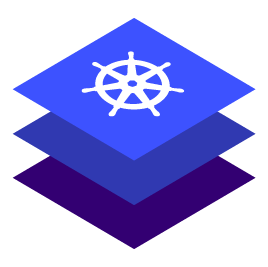CLI: Create and Configure the Tunnel

Connect a Remote Cluster
Create a tunnel connector
Create a tunnel connector on the Management cluster for the remote cluster.
Establish a variable for the connector. Provide the name of the connector, by replacing the
<connector_name>placeholder:CODEconnector=<connector_name>Create the
TunnelConnectorobject:CODEcat > connector.yaml <<EOF apiVersion: kubetunnel.d2iq.io/v1alpha1 kind: TunnelConnector metadata: namespace: ${namespace} name: ${connector} spec: gatewayRef: name: ${gateway} EOF kubectl apply -f connector.yamlAfter you create the
TunnelConnectorobject, DKP creates amanifest.yaml. Thismanifest.yamlcontains the configuration information for the components required by the tunnel for a specific cluster.Verify the connector exists:
CODEkubectl get tunnelconnector -n ${namespace} ${connector}Wait for the tunnel connector to reach
Listeningstate and then export the agent manifest:CODEwhile [ "$(kubectl get tunnelconnector -n ${namespace} ${connector} -o jsonpath="{.status.state}")" != "Listening" ] do sleep 5 done manifest=$(kubectl get tunnelconnector -n ${namespace} ${connector} -o jsonpath="{.status.tunnelAgent.manifestsRef.name}") while [ -z ${manifest} ] do sleep 5 manifest=$(kubectl get tunnelconnector -n ${namespace} ${connector} -o jsonpath="{.status.tunnelAgent.manifestsRef.name}") done kubectl get secret -n ${namespace} ${manifest} -o jsonpath='{.data.manifests\.yaml}' | base64 -d > manifest.yamlThe
manifest.yamlis applied successfully after the command completes.Fetch the
manifest.yamlto use it in the following section:CODEkubectl get secret -n ${namespace} ${manifest} -o jsonpath='{.data.manifests\.yaml}' | base64 -d > manifest.yaml
When attaching several clusters, ensure that you fetch the manifest.yaml of the cluster you are attempting to attach. Using the wrong combination of manifest.yaml and cluster will cause the attachment to fail.
Set up the managed cluster
In the following commands, the --kubeconfig flag ensures that you set the context to the Attached or Managed cluster. For alternatives and recommendations around setting your context, refer to Provide Context for Commands with a kubeconfig File.
Apply the
manifest.yamlfile to the Attached or Managed cluster and deploy the tunnel agent:CODEkubectl apply --kubeconfig=<managed_cluster_kubeconfig.conf> -f manifest.yamlCheck the status of the created pods:
CODEkubectl get pods --kubeconfig=<managed_cluster_kubeconfig.conf> -n kubetunnelAfter a short time, expect to see a
post-kubeconfigpod that reachesCompletedstate and atunnel-agentpod that stays inRunningstate.CODENAME READY STATUS RESTARTS AGE post-kubeconfig-j2ghk 0/1 Completed 0 14m tunnel-agent-f8d9f4cb4-thx8h 0/1 Running 0 14m
Add the Attached or Managed cluster into Kommander
When you create a cluster using the DKP CLI, it does not attach automatically.
On the Management cluster, wait for the tunnel to be connected by the tunnel agent:
CODEwhile [ "$(kubectl get tunnelconnector -n ${namespace} ${connector} -o jsonpath="{.status.state}")" != "Connected" ] do sleep 5 doneEstablish variables for the managed cluster. Replace the
<private_cluster>placeholder with the name of the managed cluster:CODEmanaged=<private-cluster> display_name=${managed}Update the
KommanderClusterobject:CODEcat > kommander.yaml <<EOF apiVersion: kommander.mesosphere.io/v1beta1 kind: KommanderCluster metadata: namespace: ${namespace} name: ${managed} annotations: kommander.mesosphere.io/display-name: ${display_name} spec: clusterTunnelConnectorRef: name: ${connector} EOF kubectl apply -f kommander.yamlWait for the Attached or Managed cluster to join:
CODEwhile [ "$(kubectl get kommandercluster -n ${namespace} ${managed} -o jsonpath='{.status.phase}')" != "Joined" ] do sleep 5 done kubefed=$(kubectl get kommandercluster -n ${namespace} ${managed} -o jsonpath="{.status.kubefedclusterRef.name}") while [ -z "${kubefed}" ] do sleep 5 kubefed=$(kubectl get kommandercluster -n ${namespace} ${managed} -o jsonpath="{.status.kubefedclusterRef.name}") done kubectl wait --for=condition=ready --timeout=60s kubefedcluster -n kube-federation-system ${kubefed} kubectl get kubefedcluster -n kube-federation-system ${kubefed}After the command completes, your cluster becomes visible in the DKP UI and you can start using it. Its metrics will be accessible through different dashboards such as Grafana, Karma, etc.
Create a network policy for the tunnel server
This step is optional, but improves security by restricting which remote hosts can connect to the tunnel.
Apply a network policy that restricts tunnel access to specific namespaces and IP blocks.
 The following example permits connections from:
The following example permits connections from:
- Pods running in thekommanderandkube-federation-systemnamespace.
- Remote clusters with IP addresses in the ranges 192.0.2.0 to 192.0.2.255 and 203.0.113.0 to 203.0.113.255.
- Pods running in namespaces with a labelkubetunnel.d2iq.io/networkpolicythat match the tunnel name and namespace.CODEcat > net.yaml <<EOF apiVersion: networking.k8s.io/v1 kind: NetworkPolicy metadata: namespace: ${namespace} name: ${connector}-deny labels: kubetunnel.d2iq.io/tunnel-connector: ${connector} kubetunnel.d2iq.io/networkpolicy-type: "tunnel-server" spec: podSelector: matchLabels: kubetunnel.d2iq.io/tunnel-connector: ${connector} policyTypes: - Ingress --- apiVersion: networking.k8s.io/v1 kind: NetworkPolicy metadata: namespace: ${namespace} name: ${connector}-allow labels: kubetunnel.d2iq.io/tunnel-connector: ${connector} kubetunnel.d2iq.io/networkpolicy-type: "tunnel-server" spec: podSelector: matchLabels: kubetunnel.d2iq.io/tunnel-connector: ${connector} policyTypes: - Ingress ingress: - from: - namespaceSelector: matchLabels: kubernetes.io/metadata.name: "kube-federation-system" - namespaceSelector: matchLabels: kubernetes.io/metadata.name: "kommander" - namespaceSelector: matchLabels: kubetunnel.d2iq.io/networkpolicy: ${connector}-${namespace} - ipBlock: cidr: 192.0.2.0/24 - ipBlock: cidr: 203.0.113.0/24 EOF kubectl apply -f net.yamlTo enable applications running in another namespace to access the attached cluster, add the label
kubetunnel.d2iq.io/networkpolicy=${connector}-${namespace}to the target namespace:CODEkubectl label ns ${namespace} kubetunnel.d2iq.io/networkpolicy=${connector}-${namespace}All pods in the target namespace can now reach the attached cluster services.
